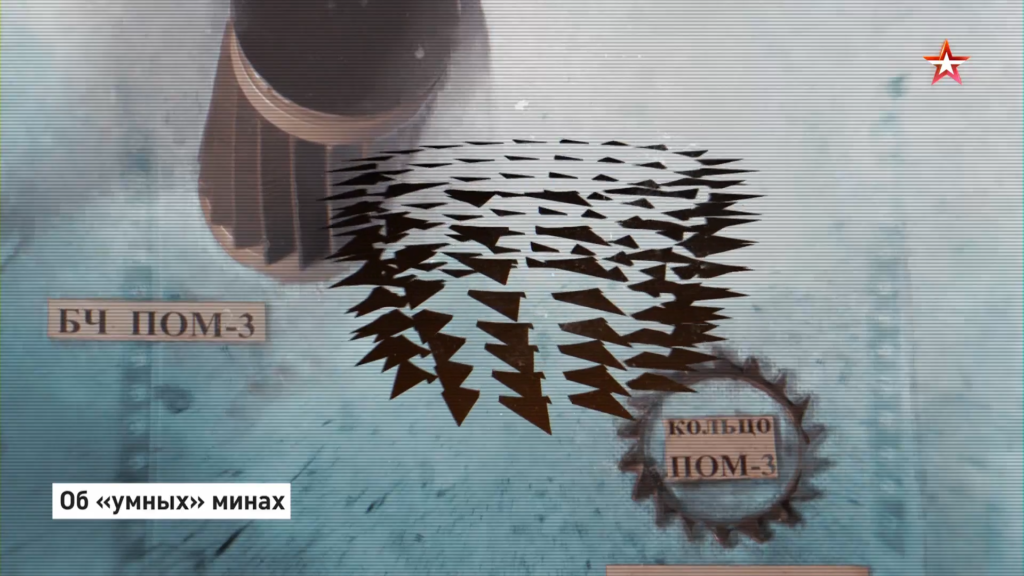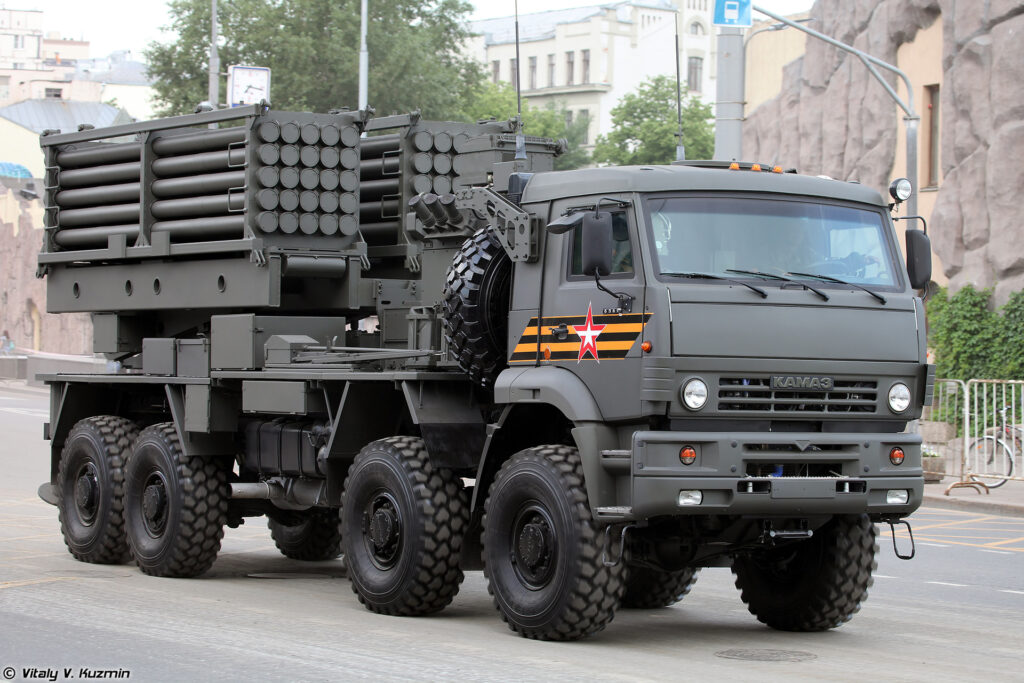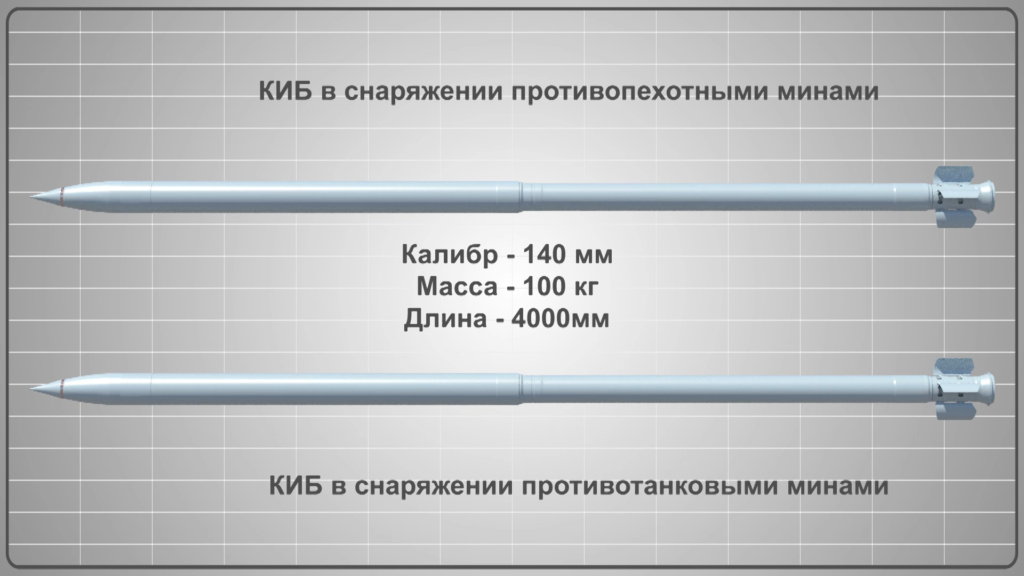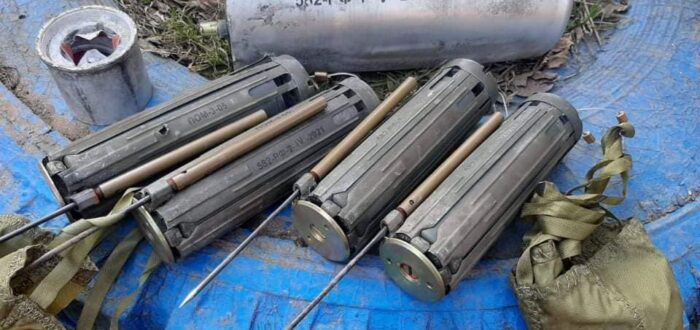Mick F. & N.R. Jenzen-Jones
On the 28 March 2022, a pro-Ukrainian Facebook account posted several pictures of Protivopekhotnaya Oskolochnaya Mina 3 (противопехотная осколочная мина; ПОМ-3; POM-3) scatterable anti-personnel (AP) landmines and one КБ ПОМ-3 (KB POM-3) cassette—each holding four POM-3 mines—apparently taken in Kharkiv Oblast, in the east of Ukraine (bordering the Russian Federation). These images show markings which indicate that the KB POM-3 was produced in 2021, implying that the mines were likely also produced very recently (see Figure 1). Unlike display examples photographed in 2019, marked “КПОМ-3”, the cassette recovered in Ukraine is marked “КБ ПОМ-3”, possibly standing for кассета блок противопехотная осколочная мина (Kasetta Blok Protivopekhotnaya Oskolochnaya Mina 3; ‘cassette block POM-3’), instead of simply ‘cassette POM-3’.

The POM-3 was unveiled in 2015 as the successor to the Soviet POM-2 series of scatterable AP mines. The POM-3 (sometimes referred to as the ‘Медальон’, or ‘Medallion’) is manufactured by JSC NPK Tekhmash, and uses a seismic proximity fuze—the seismic sensor embedded into the ground upon contact—to detect human footsteps, collecting data on vibrations proximate to the mine and comparing this data with seismic signatures in the munition’s onboard catalogue. If the vibrations are similar enough to the correct seismic signatures in the landmine’s memory, and have sufficient and increasing amplitude (indicating movement towards the mine), the munition is triggered. After the mine is triggered, an expelling charge detonates, projecting the warhead to approximately 1–1.5m above ground level, at which point the warhead detonates. This ‘bounding’ action maximises the lethality of the munition, project fragmentation at a height more likely to strike vital organs in a target’s body. The POM-3 is has a fragmenting body consisting of numerous ‘toothed’ rings that are stacked in a slightly offset manner to produce the mine‘s partially pre-formed fragmentation effect (see Figure 2). A parachute orients the mine after it is deployed from its cassette.

The mine is purportedly equipped with artificial intelligence (AI) that can recognise friendly soldiers, thus minimising the risk of collateral damage. This claim has not been established by independent sources. Additionally, the landmine can be armed for a variable period; after this it disarms itself. Claims that the mine can differentiate between soldier and civilian seem implausible given what has been made public about the mine’s sensors. It is possible that a magnetic influence sensor may be present or have been intended for future development. Deliveries of POM-3 AP mines to the Russian military started in early 2019.

The POM-3 is deployed by the ‘remote mining engineering system’ (инженерная система дистанционного минирования; Inzhenernaya Sistema Distantsionnogo Minirovaniya; ISDM) Zemledeliye (Земледелие; ‘Agriculture’), built by NPO Splav around a KamAZ-6560 8 × 8 vehicle. The ISDM first debuted at the Moscow Victory Day Parade in May 2020, and began to be issued to Russian troops toward the end of that year. The Zemledeliye minelaying system fires four-metre-long, 140 mm over-calibre rockets (with 122 mm rocket engines), each carrying an undisclosed number of KB POM-3 cassettes. Given the estimated overall length of the KB POM-3 as between 450 and 500 mm, it is estimated that each four-metre-long KIB rocket can carry 3 KB POM-3 cassettes, for a total of 12 POM-3 landmines per rocket.
Each Zemledeliye minelaying vehicle carries two blocks of 25 launch tubes, for a maximum total of 50 rockets dispersing an estimated total of 600 POM-3 landmines. Each block of 25 launch tubes, called a ‘transport and launch container’ (Транспортно-пусковые контейнеры; Transportno-puskovyye konteynery; TPK) weighs 3.8 tons, and can be transported and loaded separately. The Zemledeliye system is able to deploy a minefield at a distance of 5 to 15 km. According to Russian state sources, the vehicle’s sensors automatically creates a digital map of the minefield after it has been laid. The weapon has now been deployed in the area of Kharkiv City (Kharkiv Oblast) during the recent Russian invasion of Ukraine. At least two vehicles were documented firing their rockets at an unknown target. One video shows full salvos of 50 rockets being fired from two vehicles.

JSC NPK Tekhmash also designed the Protivo Tankovaya Mina 4 (Противо Танковая Мина; ПТМ; PTM-4), which is a scatterable anti-tank (AT) landmine, and was reportedly working on a multipurpose (anti-tank and anti-personnel) landmine designated PTM-5, which likely finished development in late 2020.
Technical Characteristics
POM-3 scatterable anti-personnel landmine
Height: 200 mm
Diameter: 60–70 mm
Weight: 1.3 kg
Fragmentation: ~1,850 fragments
Effective range: 8–13 m (depending on if protective equipment is worn)
Shelf life: 11 years
Number of POM-3 mines in KB POM-3 cassette: 4

KIB rockets*
Diameter: 140 mm (122 mm rocket motor)
Overall length: 4,000 mm
Weight: 100 kg
*Russian army designation unknown at this time

Special thanks to Charlie Randall and Ivan Kochin.
Sources
ARES (Armament Research Services). n.d. Conflict Materiel (CONMAT) Database. Confidential. Perth: ARES.
Drozdenko, Dmitry. 2017. Проклятие вражеской пехоты: чем страшна мина ПОМ-3 [‘The curse of the enemy infantry: what is the terrible POM-3 mine?’]. Zvezda. 26 September. <https://tvzvezda.ru/news/201709260758-b9rq.htm>.
Gurov, S.V. 2021. Опытная инженерная система дистанционного минирования “Земледелие” [‘Experimental engineering system for remote mining “Agriculture”’]. Ракетная Техника. 21 May. <https://missilery.info/missile/isdm>.
Gurov, S.V. 2022. Иностранное СМИ о боевом дебюте инженерной системы дистанционного минирования “Земледелие” в ходе специальной военной операции ВС РФ [‘Foreign media about the combat debut of the “Agriculture” remote mining engineering system during a special military operation of the RF Armed Forces’]. Ракетная Техника. 30 March. <https://missilery.info/missile/isdm>.
Kirill, Ryabov. 2022. Противопехотная мина ПОМ-3. Современное оружие для современной войны [‘Anti-personnel mine POM-3. Modern weapons for modern warfare’]. Военное Обозрение. 2 April. <https://topwar.ru/194251-protivopehotnaja-mina-pom-3-sovremennoe-oruzhie-dlja-sovremennoj-vojny.html>.
Rostec. 2020. Ростех начал поставки машин дистанционного минирования «Земледелие» в войска [‘Rostec began deliveries of “Agriculture” machines for remote mining to the troops’]. 24 December. <rostec.ru/news/rostekh-nachal-postavki-mashin-distantsionnogo-minirovaniya-zemledelie-v-voyska/?sphrase_id=4835768>.
Rostec. 2021. Ростех показал на «Армии-2021» боевые возможности новейших систем ТОС-2 и ИСДМ [‘Rostec showed combat capabilities of the latest TOS-2 and ISDM systems at Army-2021’]. 23 August. <https://www.rostec.ru/news/rostekh-pokazal-na-armii-2021-boevye-vozmozhnosti-noveyshikh-sistem-tos-2-i-isdm/?sphrase_id=4835768>.
TASS. 2019. В России до конца 2020 года создадут многоцелевые мины нового поколения [‘In Russia, by the end of 2020, a new generation of multi-purpose mines will be developed’]. 15 December. <https://tass.ru/armiya-i-opk/7352759>.
Union of Machine Builders of Russia. 2019. ‘«Армия-2019»: «Умные» мины от концерна «Техмаш»’. <https://soyuzmash.ru/news/companies-news/armiya-2019-umnye-miny-ot-kontserna-tekhmash/>.
Voyennoye Obozreniye. Применение новейшей системы дистанционного минирования «Земледелие» под Харьковом показали на видео [‘The use of the latest remote mining system “Agriculture” near Kharkov was shown on video’]. Военное Обозрение. 27 March. <https://topwar.ru/194033-primenenie-novejshej-sistemy-distancionnogo-minirovanija-zemledelie-pod-harkovom-pokazali-na-video.html>.
World War III. 2015. Противопехотная мина “Медальон” ПОМ-3 – новинка ВПК России [‘Anti-personnel mine “Medallion” POM-3 – a novelty of the military-industrial complex of Russia’]. 12 November. <http://www.3world-war.su/vooruzhenie/vooruzhenie-rossii/1168-protivopehotnaja-mina-medalon-pom-3-novinka-opk.html>.
Remember, all arms and munitions are dangerous. Treat all firearms as if they are loaded, and all munitions as if they are live, until you have personally confirmed otherwise. If you do not have specialist knowledge, never assume that arms or munitions are safe to handle until they have been inspected by a subject matter specialist. You should not approach, handle, move, operate, or modify arms and munitions unless explicitly trained to do so. If you encounter any unexploded ordnance (UXO) or explosive remnants of war (ERW), always remember the ‘ARMS’ acronym:
AVOID the area
RECORD all relevant information
MARK the area from a safe distance to warn others
SEEK assistance from the relevant authorities

